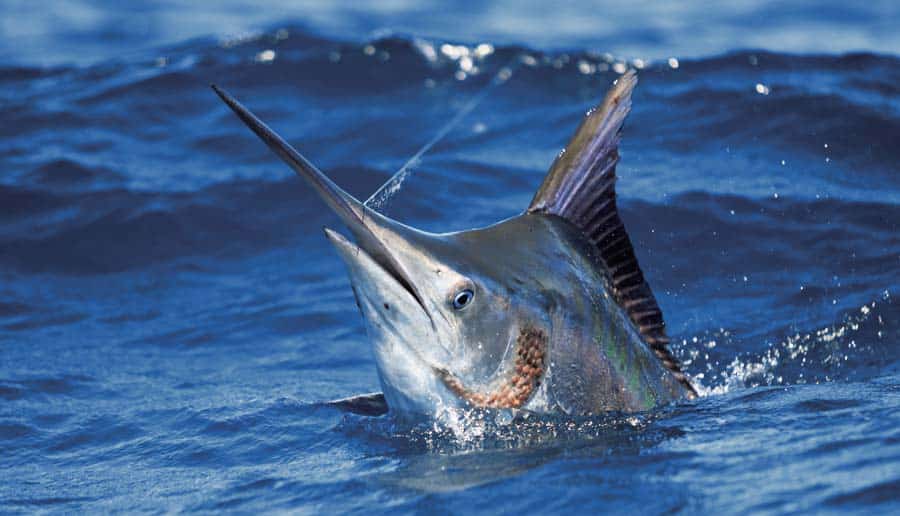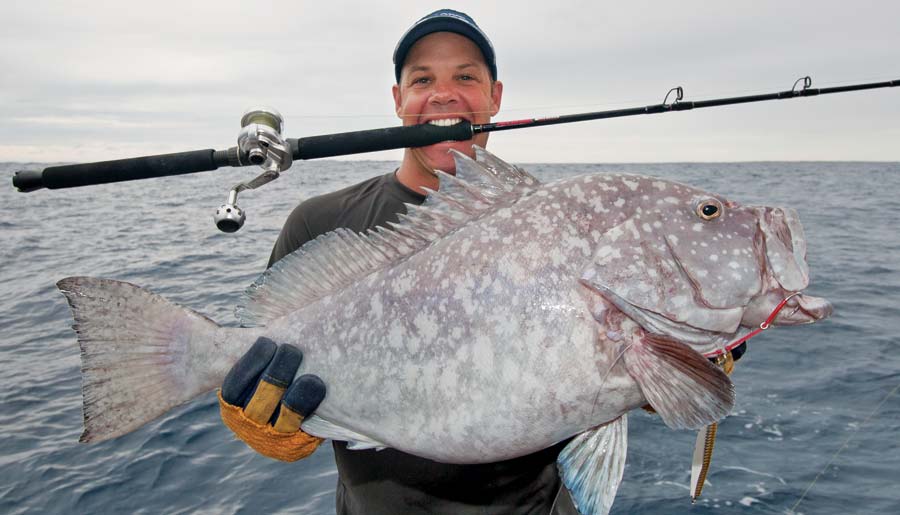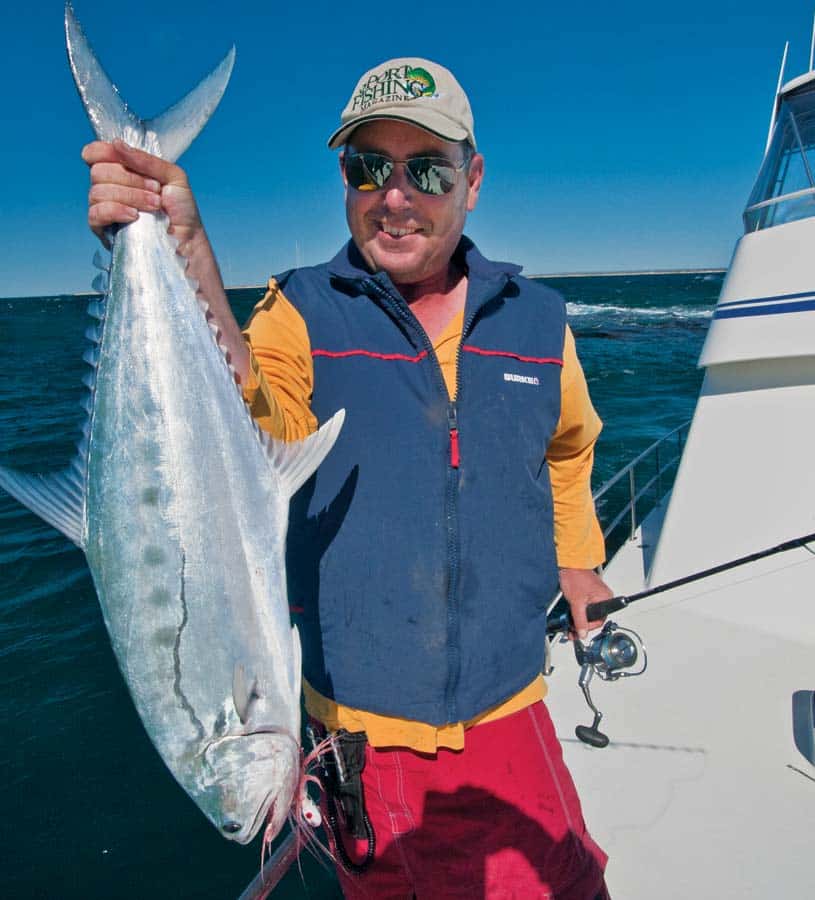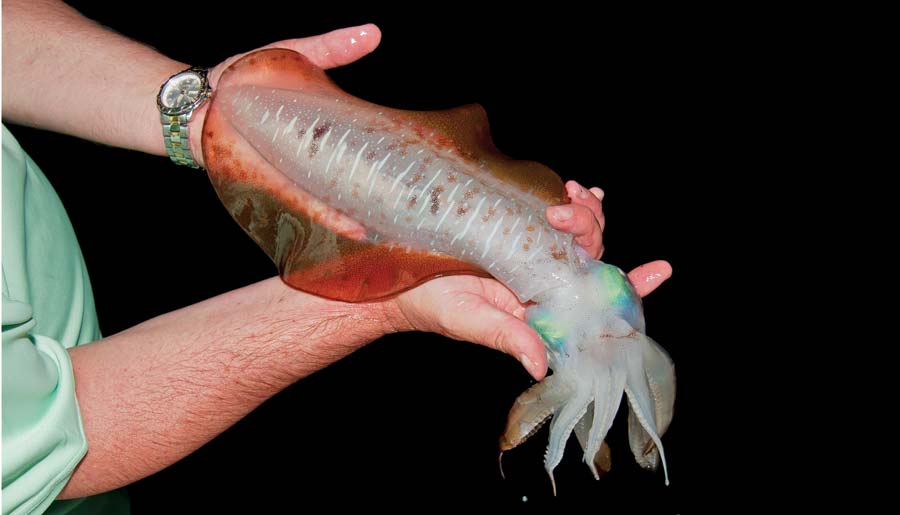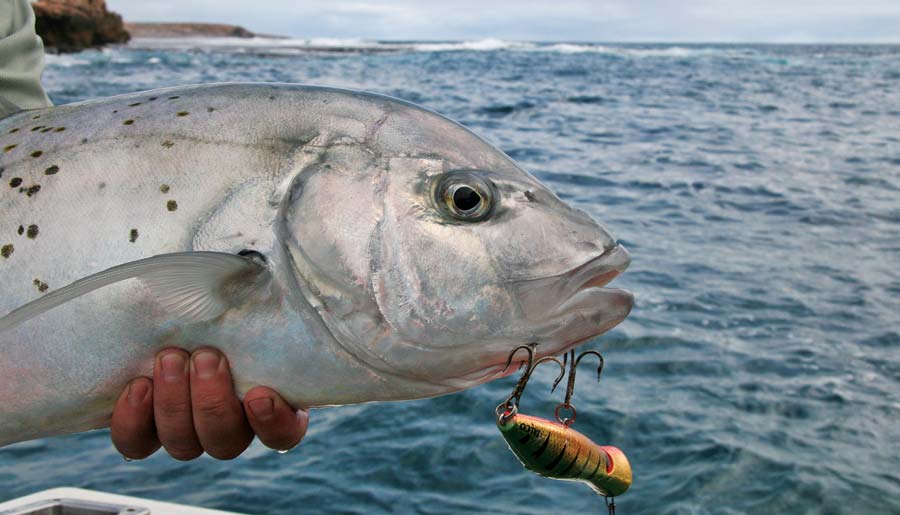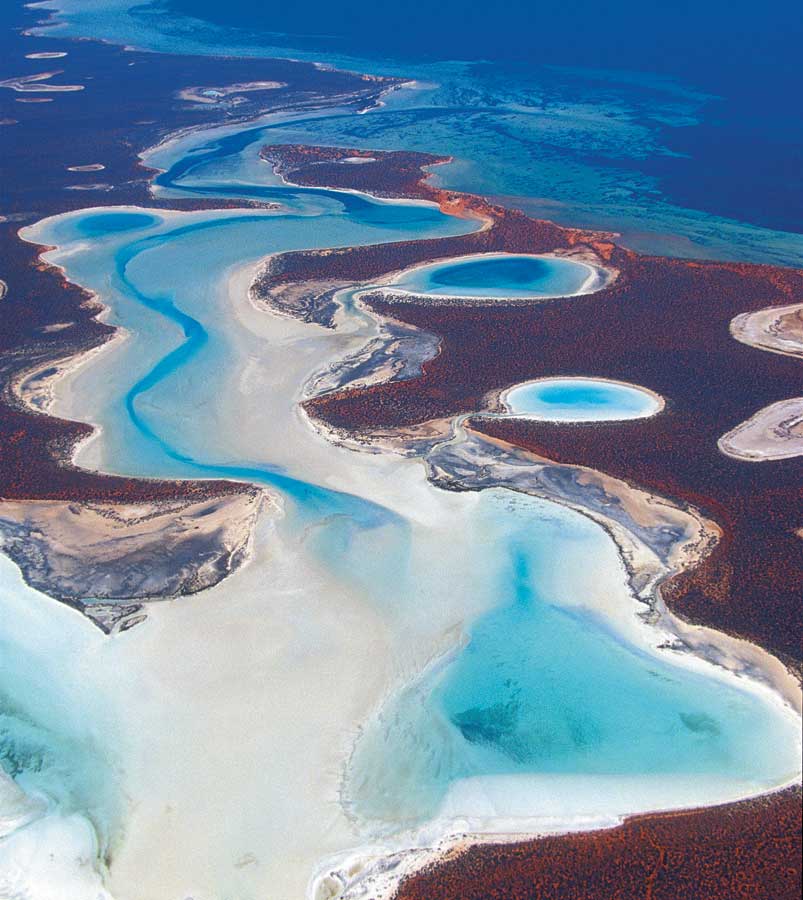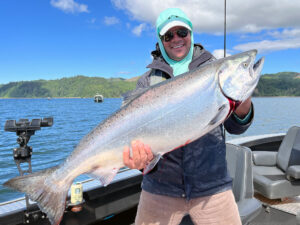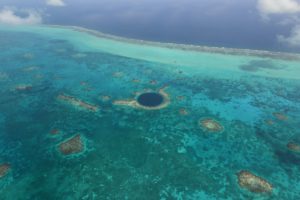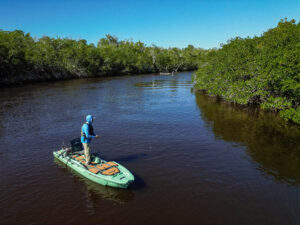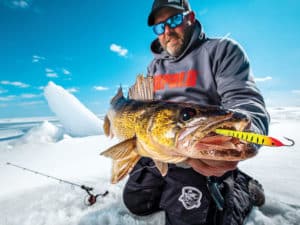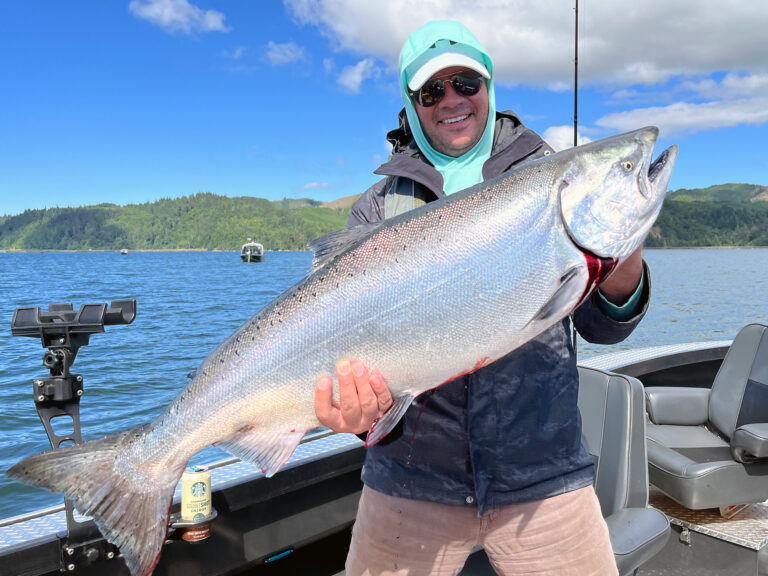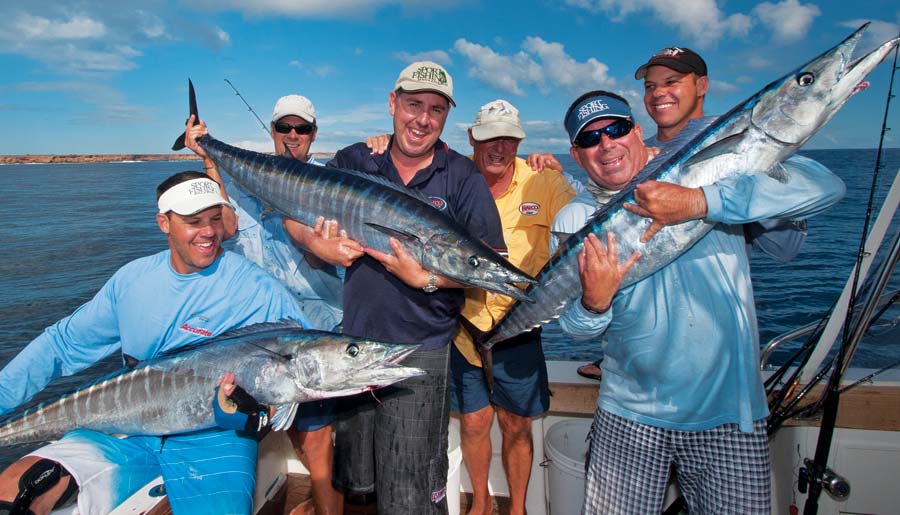
When fishing’s so hot that a major tackle manufacturer has to call from the ship to have more lures sent up the coast via next-day air to replace all those lost in the first two days of fishing, that speaks volumes.
After encountering sizzling action out of Shark Bay, off Australia’s far side — its Indian Ocean coast (aka the coral coast or Gascoyne region) — that was the dilemma faced by Ben Patrick, owner of Australia’s popular Halco lures.
I was one of six other anglers joining Ben, among them Halco’s marketing and product-development manager Tim Carter, and Ben’s dad, Neil — who brought Halco to prominence and has for decades been an International Game Fish Association trustee. By the end of our second day of fishing within a short run of the coast, we had lost countless Roosta Popper lures to narrow-barred Spanish mackerel and Laser Pro diving plugs to rapacious wahoo. Even wire traces were bitten off or occasionally bitten through; Ben added more premade traces to the lure order as well.
On the second evening, aboard Ben’s 48-foot custom convertible, Mandalay, we sat at anchor in tranquil Turtle Bay, feasting on fresh wahoo (and calamari, thanks to squid attracted to the boat’s underwater Aqualuma blue lights). After dinner, Doug Nilsen called home to report in. Doug, co-owner of Accurate Fishing Products along with his brother David, also on board, were joined by their VP of sales and marketing, Ben Secrest. Before signing off, Doug handed his iPhone to Secrest for a quick hello. Since I happened to be sitting in the salon and working on my laptop, I jotted down Secrest’s comment to Doug’s wife verbatim: “Kate — you know I’ve fished a lot of places, but I’ve never seen anything like what I saw yesterday or today. It was crazy!”
Trident-Missile Launches
Everyone knows about Australia’s fabulous and famous Great Barrier Reef, but most American anglers — and quite a few Aussies — know little about the remote and mostly uninhabited coral coast of southwest Australia. I wanted to see how worthwhile the area might be as a new option for adventurous anglers looking for something different.
We started our trip at Shark Bay/Denham, to which we flew from Perth, about 400 miles south. There, aboard the Mandalay, Ben and Neil waited, ready to cast off. (While it does boast a small airport, Denham — with population numbering in three digits — held little else of interest to us.)
After an overnight at Turtle Bay (eating fresh pink snapper — actually a very large species of porgy — we’d caught an hour earlier), we cast small poppers to shark mackerel before breakfast. These sharkies were great fun and, as it turned out, a mere warm-up for what was to come.
Our first surprise of the day was the weather: The forecast had called for clear and sunny, but things started out calm, gray and drizzly. (This was far from the only weather surprise in store on this trip, but more on that later.)
We put out four Laser Pro deep-diving plugs of various sizes and colors, and started hooking fish at once. Most of the action came from Spaniards, as Australians call their narrow-barred mackerel, similar to the Atlantic’s king mackerel but with faint bars on their sides and a particularly badass disposition. The species is found throughout the IndoPacific region. We hooked one or two every so often, then suddenly all the rods were going off at once. I mentioned to Ben that, with the fish concentrated, it might be worth making a drift to throw poppers.
We did just that and, in short order, chaos reigned. Shouts of amazement arose from bow and stern as mackerel, attacking our Roosta Poppers from below, vaulted far above the surface. We’d see no telltale precursor to such Trident-missile launches; they could happen at any moment, and it was seldom long on any cast before they did, inevitably producing a chorus of cheers. More often than not, the mackerel missed the lure, but it mattered little; just seeing the high-flying, gravity-defying predators was its own reward.
More astounding still was the rare sight, as the morning went on, of dozens of Spaniards simultaneously erupting from the calm water over a large area, chasing down baitfish. Every angler stopped, mouth agape, at seeing so many freejumping torpedoes up to 40 pounds or so.
Over the course of the morning, we managed to release more narrow-barred mackerel than anyone could keep track of, but lost many to sharks as well. We also “released” a frighteningly large number of poppers during the melee, with all the bite-offs, break-offs and sharks.
**
Small Blacks Near Shore**
When the action finally slowed, we headed farther offshore in the afternoon to troll for marlin. We didn’t have to run far before putting out trolling lures; black marlin often patrol these waters within a few miles of shore. If we’d been after big blues in particular, a run of 40 miles or so to the 3,000foot zone would have been called for.
But we were looking for blacks since, in recent years, the whole nearshore coast from Shark Bay north to Exmouth and beyond has been a hotbed of activity for small black marlin, with 100- to 150-pound fish offering a fabulous lighttackle fishery Down Under in late spring through fall.
However, the black fishery often sees wide swings from season to season in availability; that’s the case for many other pelagic targets in these waters — blues, stripes, sails and yellowfin — so it can be hot for a season or two, then turn cold. Unfortunately, that day and, in fact, most of the season last year (unlike the outstanding fishing in 2010) proved a bit slim on the marlin-pickins’ side. Outside of raising a pair of sails, we didn’t see any billfish that afternoon.
Wahoo All Around
The next day we’d put on some miles, continuing our journey up the coast, keeping in mind that we had to reach Exmouth (to fly out), nearly 300 miles north of Shark Bay, on the eighth day.
But first, we couldn’t pass up the chance to have one more go with the Spaniards just after sunup if they proved to be as thick as the morning before. At first, it appeared we were in luck. Initial casts brought macks blasting from the water. But things proved different this morning. For one thing, bright sun had replaced yesterday’s overcast, low ceiling.
Plus there were the sharks.
We’re talking big sharks, of the 10-foot, bad-boy sort — at least one tiger plus bulls and other whalers. We knew we wouldn’t stand much chance of getting any mackerel to the boat and, indeed, saw some smashing (literally and figuratively) attacks on hooked fish. Some sharks even keyed in to the loud bloops made by the biggest Roosta Poppers and followed them to the boat. All of this served to remind me that it ain’t called Shark Bay for nothing.
We headed north to Dorrie Island, where our next big surprise awaited. The drop-off just outside the island proved to be wahoo city. Replacing the topwater strikes of Spaniards were slashing attacks by wahoo on trolled lures — Halco Laser Pros, Max wobbling plugs and the globally popular Giant Tremblers. More often than not, when one rod went off, so did all four, and for at least a bit, a marvelous mayhem ensued.
While yesterday’s fishing had decimated our supply of poppers, today we had to raid much of our diving-lure supply. Even though we fished fairly heavy braid and wire leaders, bite-offs and sharkings aplenty kept us rerigging. Minus those lost to sharks and three ’hoo we kept (to 50 pounds), we released more wahoo than we had count of.
Midway: Mining the Lumps
After a pleasant night in a lovely, shallow, sandy bay inside Berniar Island (also a great place for swimming), we trolled on northward, picking up several species of mackerel and some longtail tuna (the 10- to 20-pound tuna are widely called northern bluefin in Australia).
We picked up the lines and ran nearly two hours north and west (farther offshore) to some numbers Ben had been given; these held the promise of finding “lumps” on the bottom in 250 to 300 feet that should offer good jigging action.
For the most part, the seafloor off southwest Australia is rather like the Gulf of Mexico — a gently to moderately sloping bottom that’s uniformly pretty smooth. Any real structure would certainly be a gold mine for anglers. We didn’t find much structure, only slightly discernible bottom relief, but that was enough to produce some action.
Our first six bottomfish to the boat comprised six different species — red-throated emperor, pearl perch, pink snapper, gold-spot trevally, a coral trout and a dandy rankin cod (a species of grouper).
Yes, we ate very well that evening, at anchor near Carnarvon — the largest community midway between Shark Bay and Exmouth. Carnarvon sits at the Gascoyne River mouth. That’s one of the very few rivers on this arid stretch of Australian coast where rivers are dry beds most of the year. This larger river did have a bit of outflow — enough to create muddy estuarial water where the boat sat.
Knowing that drums and croakers around the world are fond of estuaries, before I joined the boys at dinner on the back deck, I baited a circle hook with a hunk of rib meat from one of the fish we’d cleaned earlier and left it to soak off the transom. I’d all but forgotten about it when the clicker sounded a short staccato alarm. I grabbed the rod, put the reel in gear to let the line come tight, and the circle hook did its work. Soon, I found myself hanging on and dipping the rod low when the fish ran under the boat, then hustling from corner to the next, until finally Tim pulled in through the tuna door a beautiful silvery mulloway, which seemed to me well over 20 pounds. Such drum — looking very much like their close relative, California’s white seabass — are considered a prized catch in this area.
Caught in the Open
The southwest coast of Australia gets its share of wind. Sure, there are calm days any time of the year, and March, April and May offer long stretches of nice weather. But wind is always a possibility.
Fortunately for us, the forecast for the next morning was light southwest winds all day — perfect for a long, 75-mile run up the coast to reefs near Coral Bay. But by midafternoon, we faced conditions very much at odds with the benign forecast. A due-north wind had started to build, and by nightfall, the Mandalay was running head-on into gale-force winds that had whipped the Indian Ocean into a frothing, confused, angry frenzy. And with the coast offering absolutely no protection from a northerly, there was nothing for it but to batten down and pound our way north in the blackness for another seven hours until we finally made Coral Bay where we could hide inside a fringing reef. That run, veterans Neil and Ben later assured me, was really tough, even for this windy region.
We hadn’t the time needed to begin to explore the waters around Exmouth by the time we made the area, and never did get into the excellent giant trevally action for which it’s known. Nor were we able to fish the huge fringing Ningaloo Reef. We did, however, find packs of good-size queenfish anxious to climb all over various lures, particularly Halco’s Hamma lure, when twitched hard to make it dart erratically.
Nor did we have the opportunity to run out to drop lines for billfish, which was a shame: Exmouth has recently become the newest hot spot among Australian billfish anglers. In addition to billfish, the area holds a great variety of game fish. Carter pointed out that Exmouth and the Gascoyne region represent a “crossover zone” where many warm-water species at the southern end of their range mix with many temperate species at the northern end of their range.
The Gulf of Exmouth is a vast body of water, and its extensive eastern side offers flats and shallows known to harbor bonefish, permit, golden and other trevallies, queenfish and more. Precious little serious effort has gone on here — though Halco recently teamed up with Australian fishing magazine Fishing World for an extended inshore adventure to better assess the potential of Exmouth’s extensive inshore fishery. (Read that account and see images at fishingworld.com.au/news/sneak-peek-amazing-exmouth.)
Even with all we did get to see and do, eight full days wasn’t nearly enough to truly explore and fish this area — offshore, nearshore and inshore.
The far side of Australia is a fascinating place for anglers with the means and sense of adventure to experience it.
Fishing the Far Side
Getting there: Fly into Perth for starters. We flew Air New Zealand (airnewzealand.com). Along with its high ratings (airlinequality.com), ANZ has many flights from L.A. and San Francisco directly into Auckland, and offers nonstops to Perth from there. Fly up to Exmouth or Shark Bay from Perth via Skywest (skywest.com.au).
TIMING: For the calmest, most pleasant fishing, figure March, April and May. That’s normally a good time for many game fish, including billfish. Also, the Australian International Billfish Tournament is held in fall, this year March 19 to 23 (for information, visit egfc.com.au, site of the Exmouth Game Fishing Club). If you can take the seas — since October through February can be cob-rough — anglers will find the best black marlin fishing from spring through fall. October’s also a good month for baitballs and sailfish.
To book charters or get more information:
Coral Bay
Coral Bay Ocean Game Fishing Charters
Capt. Bernie Vale
www.mahimahicoralbay.com.au
Shark Bay
Dirk Hartog Island Lodge
Capt. Keiran Wardle
www.dirkhartogisland.com
Exmouth
On Strike Charters
Capt. Josh Bruymnzeel
www.onstrike.com.au
Reel Teaser Charters
Capt. Ross Newton
www.reelteasercharters.com
True Blue Bones
Capt. Brett Wolf
www.truebluebonefish.com.au
(inshore: bonefish, permit, queenfish, etc.)
Tackle World Bluewater Exmouth
A large, impressively well-equipped tackle dealer run by and for serious enthusiasts, and a great source of information about fishing the area.
www.bluewater.net.au

